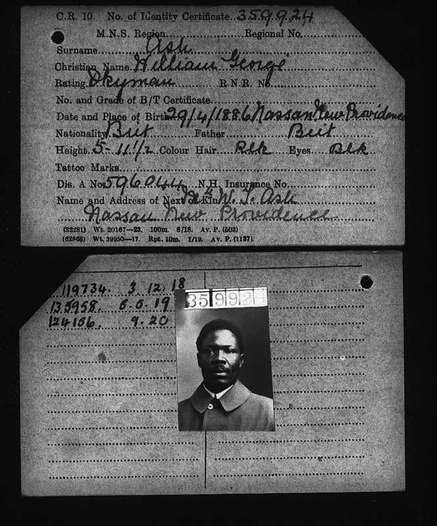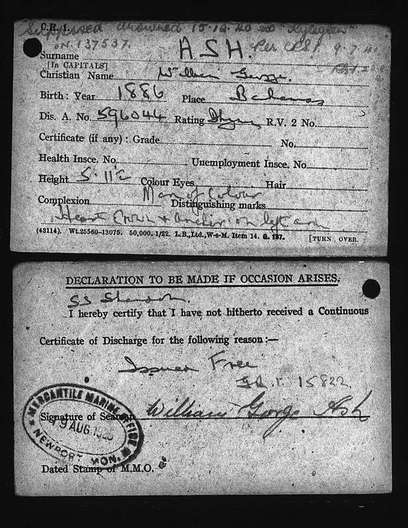William George Ash was born on 29 April 1886 in Nassau, New Providence, Bahamas. It is probable that he travelled to Britain in the early twentieth century to pursue a career at sea.
On 3 December 1818, Ash gained employment as a donkeyman on board the Visigoth which sailed from Liverpool across the Atlantic to Portland, Maine.[1] By June 1919, he was in Hull where he joined the crew of the steamship, Great City. While his profession took him to distant shores, over the subsequent three decades the West Indian seaman constantly returned to Hull and it is probable he lived in the region for many years.
Between 1920 and 1928, Ash worked as a donkeymen on over eight different vessels which all travelled to various American and European ports. It is probable that he was based in Hull during this time. However, the nature of his work meant that he was very rarely at home.
In early 1929, Ash took a four-year break from sailing on board British vessels. He did not board another ship in England until 1933. However, unfortunately no evidence has yet been found to suggest his whereabouts during this hiatus.
Between 1920 and 1928, Ash worked as a donkeymen on over eight different vessels which all travelled to various American and European ports. It is probable that he was based in Hull during this time. However, the nature of his work meant that he was very rarely at home.
In early 1929, Ash took a four-year break from sailing on board British vessels. He did not board another ship in England until 1933. However, unfortunately no evidence has yet been found to suggest his whereabouts during this hiatus.
|
In the five years after 1933, the West Indian donkeymen was employed on board three vessels. When the Second World War broke out in 1939, Ash had not been aboard a British steamer for around nine months. The lengthy gaps in his sailing history may have been because he took employment on board foreign vessels. However, it is more likely that he substituted his career at sea, for one on dry land in Hull. Thus, only when he was out of work or required extra income, did he return to his profession as a sailor. Although, he had not worked on board a British steamship for almost two years, in early December 1940, Ash left his home at 16 Gernstead Grove, Preston Road, Hull and joined the crew of the Kyleglen.[2] On 12 December the steamship departed from the convoy she was travelling with and ventured into the Atlantic.[3] Two days later, the Kyleglen was unexpectedly hit twice on her portside by two torpedoes launched from a German U-boat. The commander of the enemy vessel was Joachim Schepke.[4] During his career, he sunk 36 British ships and damaged a further five before he died on 17 March 1941.[5] |
Despite the fact that the commander of the enemy vessel observed that the crew had managed to abandon the ship and get themselves into lifeboats, they were never seen again. At least 36 crewmen died because of the attack on the Kyleglen. Sadly, one of these men was William George Ash. [6]
Footnotes
[1] The Scotsman, 27 December 1818, p. 2.
[2] Ibid, p. 9.
[3] U-boat.net, http://uboat.net/men/schepke.htm [accessed 05/01/2017]
[4] For information about Schepke’s career see Samuel W. Mitcham and Gene Mueller, Hitler’s Commanders: Officers of the Wehrmacht, the Luftwaffe, The Kriefsmarine, and the Waffen-SS (Plymouth: Rowman & Littlefield Publishers, 2012), Chapter 7.
[5] U-boat.net, http://uboat.net/men/schepke.htm [accessed 05/01/2017]
[6] The National Archives, Deaths at Sea 1781-1968, BT 334/0098, p. 9
[1] The Scotsman, 27 December 1818, p. 2.
[2] Ibid, p. 9.
[3] U-boat.net, http://uboat.net/men/schepke.htm [accessed 05/01/2017]
[4] For information about Schepke’s career see Samuel W. Mitcham and Gene Mueller, Hitler’s Commanders: Officers of the Wehrmacht, the Luftwaffe, The Kriefsmarine, and the Waffen-SS (Plymouth: Rowman & Littlefield Publishers, 2012), Chapter 7.
[5] U-boat.net, http://uboat.net/men/schepke.htm [accessed 05/01/2017]
[6] The National Archives, Deaths at Sea 1781-1968, BT 334/0098, p. 9



